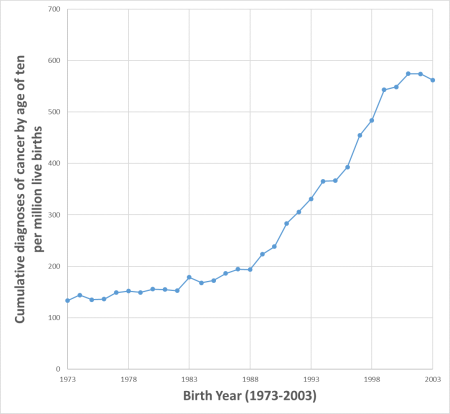Carbon 14 Decay as a Source of Somatic Point Mutations in Genes Correlated with Cancer Diagnoses
Carbon-14 decay was identified as a source of point mutations in genes associated with cancer diagnoses in glia, neurons, lymphocytes, adipocytes, vascular endothelial cells, hepatocytes, and bone marrow cells. Cumulative mean 14C decay in DNA was modeled for multiple tissue types for people born from 1973 to 2013 in the Northern hemisphere, and compared to 73,182 diagnoses of glioma, lymphoma, liposarcoma, vascular endothelial cancer, hepatocellular carcinoma, and bone cancer in the U.S. between 1973 and 2013. Significant correlations (p ≤ 0.0001) with R2 from 0.950 to 0.996 were found for several histologies. The relative pathogenic sensitivity of 85 genes with the most frequent mutations was identified from review of 289,322 mutations in sequences from 23,721 samples and diagnoses were correlated with 14C decay in genes. 14C decay nitrogen substitution was identified as a source of transcription errors analogous with the two most common point mutations cataloged during genome sequencing.
This article represents the most through and complete quantitative analysis of Carbon 14 decay in the DNA of human tissue types correlated with cancer diagnoses in the related tissues.
The full article is available here.
Resource Available: Carbon-14 Decay in DNA of Nucleated Cells by Tissue Type
Quantitative analysis of cumulative Carbon-14 decay in DNA of adipocytes, bone marrow cells, hepatocytes, lymphocytes, neurons & glia, and vascular endothelial cells is now available for U.S. births from 1973 to 2013. Cumulative Carbon-14 decay in DNA can be can be correlated with cumulative cancer diagnoses in different tissue types. For example, cumulative glioma diagnoses in the U.S. for births in 1988 through age 35 (i.e., to 2013) are correlated with cumulative Carbon-14 decays in the DNA of glia and neurons, as illustrated on the right. This data can also be correlated to genes identified as pathogenic for glioma, i.e., IDH1, TP53, TERT, ATRX, and TTN.
Please see all of the new data available on our resources page.
U.S. Adolescent Cancer Rates are Increasing
Epidemiology data for 46,997 cancer diagnoses of children aged 0-10 from 1973-2013 in the U.S. reveal that cumulative diagnoses by age 10 rose 323% from 132.9 to 562.4 per million live births from 1973 to 2003 (through 2013). This is not only a U.S. problem, however. A recent survey of 153 cancer registries confirms that childhood cancer diagnoses have increased throughout the world since the 1980s with the exception of sub-Saharan Africa. This dramatic increase in rates is often obfuscated due to cancer rate reports that mix age ranges and years of births. It is urgent that the source of this increase be identified so that rates can be reversed. Full details, references, and data are available here.
This dramatic increase must be reversed!
Increase in U.S. Cell Phone Subscriptions after 1983 Correlates with Increased Rate of Adolescent Cancer Diagnoses
Epidemiology data for 46,997 cancer diagnoses of children aged 0-10 from 1973-2013 in the U.S. were correlated with industry data for U.S. cell phone subscriptions. Cumulative diagnoses by age 10 rose 323% from 132.9 to 562.4 per million live births from 1973 to 2003 (through 2013). The highest correlation was for 7 and 8-year-olds with R2 = 0.988 and p < 0.00001. Sixteen histologies were reviewed, with glioma (i.e., brain tumors) having the highest correlation with R2 = 0.985, followed by neuroepitheliomatous neoplasms with R2 = 0.888, and Hodgkin’s lymphoma with R2 = 0.852, all p < 0.00001. Several other histologies also had significant positive correlations in bone marrow cells and lymphocytes, while malignant lymphoma was found to be uncorrelated. These findings raise questions about the current electromagnetic emissions safety standards utilized by the consumer electronics industry, and the effects of electromagnetic emissions on human tissues and intracellular processes.
Full details and data are available in a new article:
Isotope Filtration Systems and Cancer Prevention Research
The Stable Isotope Foundation is on the cutting edge of developing new technologies for cancer prevention via reducing damage to human DNA caused by unstable isotopes, which is one type of pathogenic carcinogens. Cancer caused by spontaneous genetic alteration is responsible for up to 25% of U.S. mortality, and preventing this damage is essential to reducing cancer incidents. We have developed new U.S. patent pending technologies for isotope filtration to remove unstable isotopes from agricultural products. For more information on our isotope research see here.
Interview Our Founder - Coming Soon!
You can interview our founder! Submit your questions to our founder Brett Patrick for a special public question and answer interview coming soon! You can ask about anything! Science, Technology, Engineering, Mathematics, or something else. Reasonable questions with finite responses are appreciated. Selected questions will receive a personal response in a special interview coming in 2022! Please submit your questions here with Subject: Interview.
Aeroseed™ - Presenting a Revolutionary New Forestry Technology
Aeroseed™ is a U.S. Patented technology developed by the Stable Isotope Foundation and promises to dramatically reduces the cost of reforesting. Aeroseed™ is an aerodynamic coating on seeds enabling dissemination from the air to achieve optimal penetration depths and seed orientations to optimize germination and sprout survival rates. The drag coefficient, terminal velocity, and soil penetrability are optimized by Head, Tail, and Body geometry. It is composed of organic material with nutrients, fungicide, and (opt.) anti-pest supplements. One Unmanned Aerial Vehicle (UAV) can implant tens of thousands of seeds per hour, reaching even inaccessible areas without roads or trails. Please see here for more details.
AeroseedTM germination tests are underway in several temperate zones with fifteen different species of trees including five unique genus (i.e., Abies, Juniperus, Pinus, Pseudotsuga, and Thuja). More details are available here.
Please support the
World Reforestry Project
Goal: Plant 2.5 Billion Trees by 2030
For more information click here.
Opportunity: The World Reforestry Project is currently seeking partners for reforestry initiatives and grant proposals in geographic regions within Africa, Asia, Europe, South and North America.
* In support, Stable Isotope Foundation is donating licensing, production and distribution costs.
AeroseedTM is a trademark of the Stable Isotope Foundation LLC.











